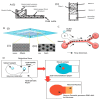Potential Point-of-Care Microfluidic Devices to Diagnose Iron Deficiency Anemia
- PMID: 30103424
- PMCID: PMC6111990
- DOI: 10.3390/s18082625
Potential Point-of-Care Microfluidic Devices to Diagnose Iron Deficiency Anemia
Abstract
Over the past 20 years, rapid technological advancement in the field of microfluidics has produced a wide array of microfluidic point-of-care (POC) diagnostic devices for the healthcare industry. However, potential microfluidic applications in the field of nutrition, specifically to diagnose iron deficiency anemia (IDA) detection, remain scarce. Iron deficiency anemia is the most common form of anemia, which affects billions of people globally, especially the elderly, women, and children. This review comprehensively analyzes the current diagnosis technologies that address anemia-related IDA-POC microfluidic devices in the future. This review briefly highlights various microfluidics devices that have the potential to detect IDA and discusses some commercially available devices for blood plasma separation mechanisms. Reagent deposition and integration into microfluidic devices are also explored. Finally, we discuss the challenges of insights into potential portable microfluidic systems, especially for remote IDA detection.
Keywords: all-in-one; iron deficiency anemia; microfluidic; point-of-care.
Conflict of interest statement
The authors declare no conflicts of interest.
Figures






References
-
- World Health Organization . The Global Prevalence of Anaemia in 2011. WHO; Geneva, Switzerland: 2011.
-
- Berger J., Dillon J.-C. Control of iron deficiency in developing countries. Sante. 2002;12:22–30. - PubMed
-
- Sukrat B., Sirichotiyakul S. The prevalence and causes of anemia during pregnancy in Maharaj Nakorn Chiang Mai Hospital. J. Med. Assoc. Thai. 2006;89(Suppl 4):S142–S146. - PubMed
Publication types
MeSH terms
LinkOut - more resources
Full Text Sources
Other Literature Sources
Miscellaneous

